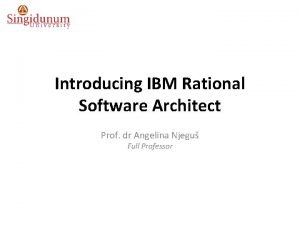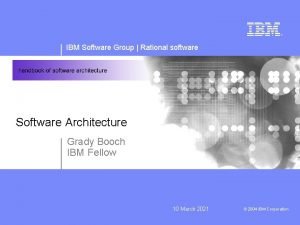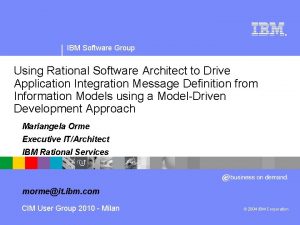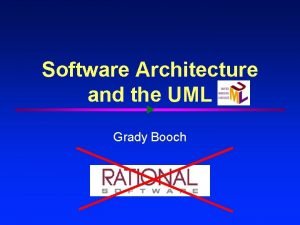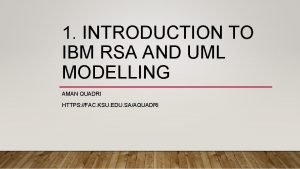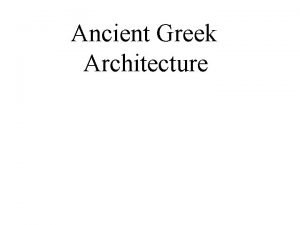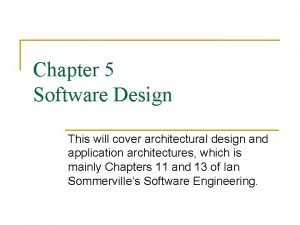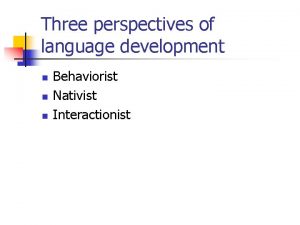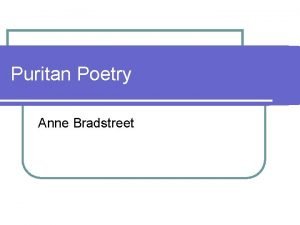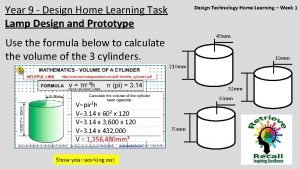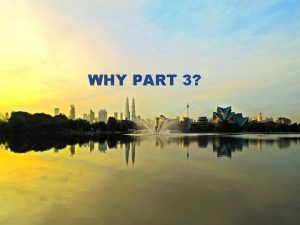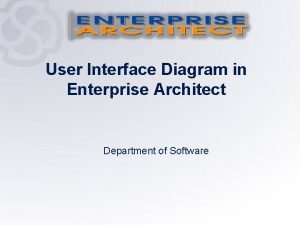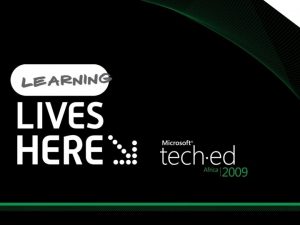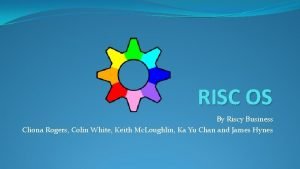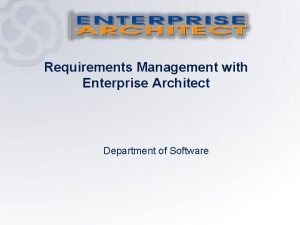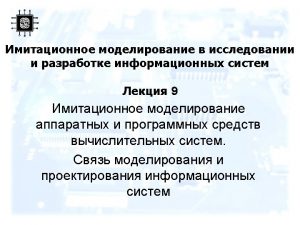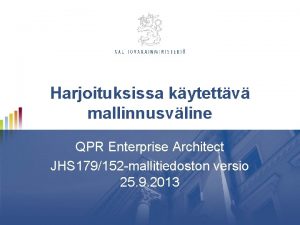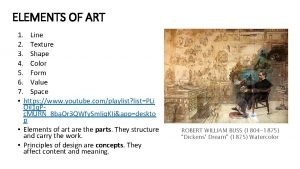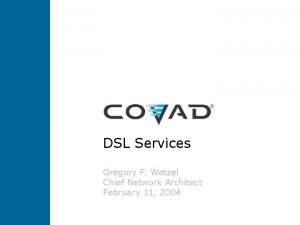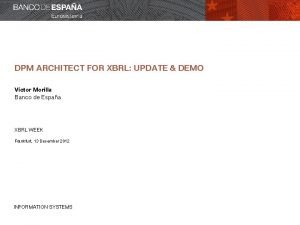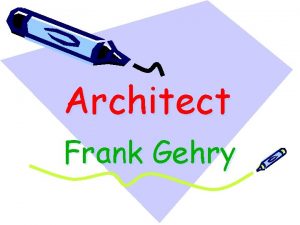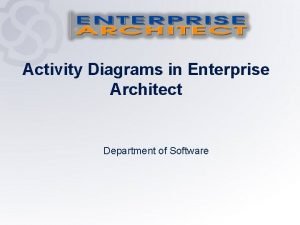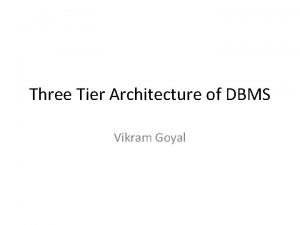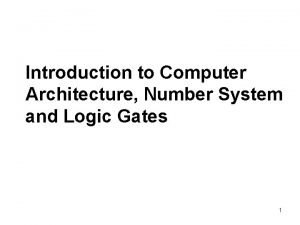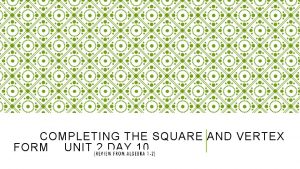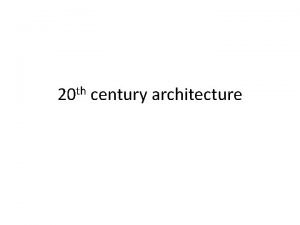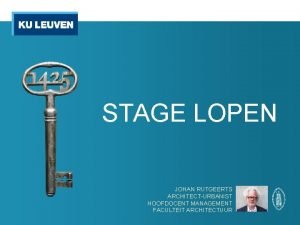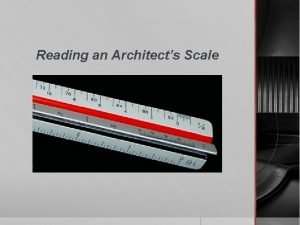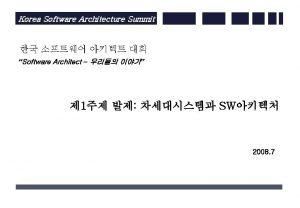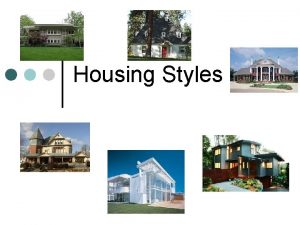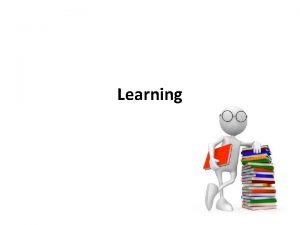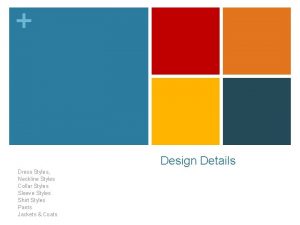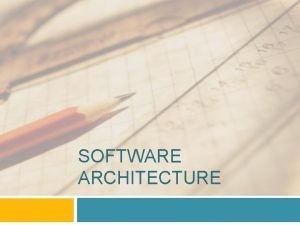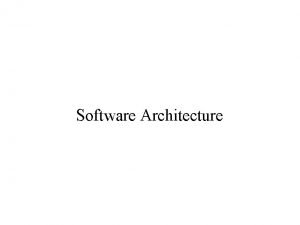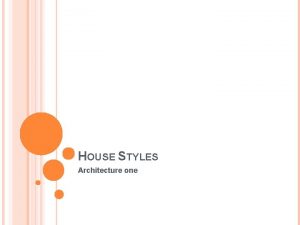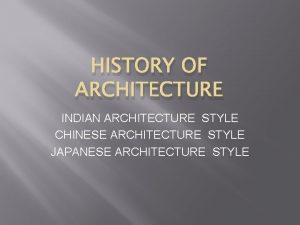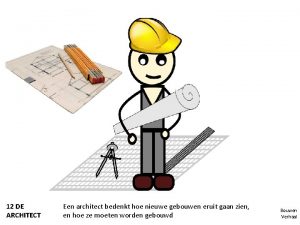SOFTWARE ARCHITECT STYLE lecture 2 Architecture Styles An



































![Example: Key Word In Context Parnas proposed the following problem[1972]: Example: Key Word In Context Parnas proposed the following problem[1972]:](https://slidetodoc.com/presentation_image/2250935d5f00a66f34ba7d82d4b126ac/image-36.jpg)














- Slides: 50

SOFTWARE ARCHITECT STYLE lecture 2

Architecture Styles § An architectural style defines a family of such systems in terms of a pattern of structural organization. § More specifically, an architectural style defines a vocabulary of components and connector types, and a set of constraints on how they combined.

Architecture Styles § Garlan and Shaw gave a general architectural style classification (classic software architecture style): § Dataflow systems: Batch sequential; Pipes and filters § Call-and-return systems: Main program and subroutine; OO systems; Hierarchical layers § Independent components: Communicating process; Event systems § Virtual machines: Interpreters; Rule-based systems § Data-centered-systems(repositories): Databases; Hypertext systems; Blackboards

DATAFLOW SYSTEMS

Dataflow Systems Batch-sequential § The batch sequential style is one of the oldest in the design of computer systems. It arose in the early days of data processing when the limitations of computing equipment required that large problems be subdivided into severable components that could communicate by the transfer of magnetic tapes. Data transformation tape report validate sort Report Update tape Data flow

Dataflow Systems § Batch Sequential § § Processing steps are independent programs Each step runs to completion before next step starts Data transmitted as a whole between steps Because of the above features, there is no need to synchronize its components § Because several components can only be run in sequence and not simultaneously, performance may be worse than programs that run concurrently on several components § Software designed using a sequential batch structure is not suitable for systems that process data in real time

Dataflow Systems § Batch Sequential § Typical uses: Transaction processing in financial systems. “The Granddaddy of Styles”

Dataflow Systems—Batch-sequential § Summary: Separate programs are executed in order; data is passed as an aggregate from one program to the next. § Components: Independent programs. § Connectors: The human hand carrying tapes between the programs § Data elements: Explicit, aggregate elements passed from one component to the next upon completion of the producing program's execution. § Topology: Linear. § Additional constraints imposed: One program runs at a time, to completion. § Qualities yielded: Severable execution; simplicity. § Typical uses: Transaction processing in financial systems. § Cautions: When interaction between the components is required; when concurrency between components is possible or required. § Relations to programming languages or environments: None.

Dataflow Systems Pipe-and-Filter § In a pipe-and-filter style each component has a set of inputs and a set of outputs. This is usually accomplished by applying a local transformation to the input streams and computing incrementally, so that output begins before input is consumed. Hence components are termed filters. The connectors of this style serve as conduits for the streams, transmitting outputs of one filter to inputs of another. Hence the connectors are termed pipes.

Dataflow Systems Pipe-and-Filter § Filter structure shown in Figure 1. A filter consists of input port, filter and output port. Input port part is responsible for storing pending data, filter is responsible for processing data, output port is responsible for storing the data has been processed. § The responsibility of the pipeline is to transport data, its structure shown in Figure 2. The pipeline consists of an Input Stream and an Output Stream, and the pipe component pipe is responsible for transferring data from the input stream to the output stream Figure 1 Figure 2

Dataflow Systems Pipe-and-Filter § Filter types are divided into Active Filter and Passive Filter. In specific applications, depending on the problem, different types of filters may be selected § Active filter features include Input data and Pull/Push the transformed data. At this point the pipeline is passive, and in order to pull and push provides an I/O mechanism. § The passive filters give the responsibility for the data to the pipes that are connected to it. Such a pipe should have the ability to pull data from the previous filter and push it to the next filter. At this point, the filter must provide I/O mechanism.

Dataflow Systems Pipe-and-Filter—Advantages § Allow the designer to understand the overall input/output behavior of a system as a simple composition of the behaviors of the individual filters. § Support reuse: any two filters can be hooked together, provided they agree on the data that are being transmitted between them. § Systems are easy to maintain and enhance: new filters can be added to existing systems and old filters can be replaced by improved ones. § Permit certain kinds of specialized analysis, such as throughput and deadlock analysis. § Naturally support concurrent execution. Each filter can be implemented as a separate task and potentially executed in parallel with other filter.

Dataflow Systems Pipe-and-Filter-Disadvantages § Pipe-and-filter systems often lead to a batch organization of processing. Although filters can process data incrementally, they are inherently independent, so the designer must think of each filter as providing a complete transformation of input data to output data. § They may be hampered by having to maintain correspondences between two separate but related streams. § Depending on the implementation, they may force a lowest common denominator on data transmission, resulting in added work for each filter to parse and unparse its data. This, in turn, can lead both to loss of performance and to increased complexity in writing the filters themselves.

Dataflow—Pipe-and-Filter § Summary: Separate programs are executed, potentially concurrently; data is passed as a stream from one program to the next. § Components: Independent programs, known as filters. § Connectors: Explicit routers of data streams; service provided by operating system. § Data elements: Not explicit; must be (linear) data streams. In the typical Unix/Linux/DOS implementation the streams must be text. § Topology: Pipeline, though T fittings are possible. § Qualities yielded: Filters are mutually independent. Simple structure of incoming and outgoing data streams facilitates novel combinations of filters for new, composed applications. § Typical uses: Ubiquitous in operating system application programming. § Cautions: When complex data structures must be exchanged between filters; when interactivity between the programs is required. § Relations to programming languages or environments: Prevalent in Unix shells.

Dataflow Systems Comparison of Batch Sequential and Pipe-and-Filter Figure 1 Batch Sequential system architecture structure Figure 2 Pipe-and-Filter system architecture structure

Dataflow Systems Comparison of Batch Sequential and Pipe-and-Filter § The similarity between the two structures lies in the mutual independence of the processing modules. In batch systems and pipe-and-filter architectures, the processes are independent of each other, that is, in a batch system architecture, each process does not call other processes; in a pipe-and-filter architecture, each filter does not call other filters.

Dataflow Systems Comparison of Batch Sequential and Pipe-and-Filter § The difference between the two architecture is: ① Data processing is different. In a sequential batch system, only the last step is done completely, the next step can start, and the data is transmitted as a block. It is common to have intermediate storage for each intermediate step. Each process is not working at the same time, and only when the previous adjacent processing is completed can the process begin to work. In the pipe-and-filter architecture, the filters incrementally transform data in a stream-by-stream manner, with each filter working simultaneously. ② The amount of data processed is different. The amount of data processed by the batch sequential system is limited, while the amount of data processed by the pipe-and-filter architecture is infinite.

CALL-AND-RETURN

Call-and-return Introduction to unstructured programming § Unstructured programming technology is the earliest programming paradigm. A program written in an unstructured language usually contains a series of ordered commands (statements), usually one line per statement, with a line number or label for each line, allowing the program execution stream to be sorted from one line Jump to other specified lines of the program. § Unstructured programming introduces the concept of control loops such as basic loops, branches and jumps. Subroutines in unstructured programming allow multiple inlets and multiple outlets, allowing programs to be transferred to and from subroutines anywhere.

Call-and-return Concept of Call-and-return architecture structure § Software systems designed with a call-and-return style software architecture use a divide-and-conquer strategy whose main idea is to break down a complex large system into subsystems in order to reduce complexity and increase modifiability. The system's program execution sequence is usually controlled by only a single thread. § Each software component is designed to have a unique program execution starting point and a unique program execution end point. The program starts executing the code of the component from the beginning of its execution. The program execution is completed, and control is returned to the program invoking component, where the program component is usually called a subroutine and the control transfer from one component to another is called a subroutine call.

Call-and-return Concept of Call-and-return architecture structure Call-and-return software architecture program control flow diagram

Call-and-return Main Program and Subroutines § The main program and subroutines software architecture uses hierarchical partitioning in design, which uses single control thread directly supported by the programming language. § The structure of the subroutine is clear, and the subroutines usually make up the program module. Subroutine calls appear hierarchical, and its correctness often depends on the correct subroutine call.

Call-and-return Main Program and Subroutines § The design philosophy of top-down functional method is that the system is designed from a functional point of view, starting from the top, and gradually refined into a detailed design. Based on the functional requirements of the system to be completed, the design divides a whole problem into several sub-problems first and then considers each sub-problem to be subdivided into several smaller sub-problems again, and then continues until it can not be further divided. § Structured design begins with the data flow diagram and then transforms it into a program structure diagram. These diagrams need to be described in a canonical DFD to achieve a well-understood understanding of the system before it is established. In the design, the development stage needs to be strictly divided, and the work of each stage should be precisely described by the standard methods and charting tools. Each stage takes the standardized documents and materials as the result and finally obtains the system that meets the needs of users.

Call-and-return Main Program and Subroutines

Call-and-return Top-down programming has the following problems: § Functional evolution is difficult The top-down approach creates a better software system model that meets the initial requirements. But as the system changes or adds new demands, the functional structure becomes more clumsy. Because software is designed as a tree structure, modifications and updates often require extensive "pruning" and "grafting, " making system maintenance more and more difficult. § The actual system function is not easy to describe Large-scale interactive system is difficult to describe from the functional aspects. Many large systems do not have a "top", for example, a software system that involves data queries, data changes, and data consistency. If followed by a functional topdown design, the system may be designed to be based on a unique "Virtual" vertices and produce very complex structures.

Call-and-return Top-down programming has the following problems: § Functional Design Loses Data and Data Structure. Because system decomposition highlights only the functional aspects of the problem, the impact of the data structure on the problem is lost § Software products designed by function produce less reusable code. The design of each program unit considers only very limited requirements, because these specific requirements are less likely to appear in the next question, so the resulting design and code is not universal and generic.

Call-and-return Main Program and Subroutines § Summary: Decomposition based upon separation of functional processing steps. § Components: · Main program and subroutines. § Connectors: Function/procedure calls. § Data elements: Values passed in/out of subroutines. § Topology: Static organization of components is hierarchical; full structure is a directed graph. § Additional constraints imposed: None. § Qualities yielded: Modularity: Subroutines may be replaced with different implementations long as interface semantics are unaffected. § Typical uses: . Small programs; pedagogical purposes § Cautions: Typically fails to scale to large applications; inadequate attention to data structures. Unpredictable effort required to accommodate new requirements. § Relations to programming languages. or environments: Traditional imperative programming languages, such as BASIC, Pascal, or C.

Call-and-return Object-Oriented § Object-oriented design and programming methods allow programmers to encapsulate data and limit access to data. § An object is an entity that binds data to operations (ie, functions or methods) that access and maintain the data. Objects provide some easy-to-use, standardized methods to manipulate their data and hide the tedious details of their specific tasks. § In object-oriented design, the system is seen as consisting of a collection of objects (rather than functions or methods) that send messages from one object to another. Each object has its own related functions.

Call-and-return Object-Oriented architecture structure

Call-and-return Object-Oriented--Advantage § Easy to maintain: Because an object hides its internal representation from the client, its internal implementation can be changed without affecting those clients. § Reusability: The object is suitable for reuse components. § Mapping the real world: For many software systems there are obvious real-world entity to system objects. § Easy to split a system: Object-Oriented design bind data access, control methods together to form a class, the object is generated by the class. Enables software designers to divide the entire problem into a series of interacting objects.

Call-and-return Object-Oriented—Disadvantage § Object-oriented programs occupy large memory. This is because each newly created object must occupy a piece of memory during program execution, whereas in object-oriented programs, a large number of objects are often created. § In order for one object to interact another(via procedure call) it must know the identity of that other object, including the object name, method name and parameter type. § In object-oriented systems, whenever the identity of an object changes it is necessary to modify all other objects that explicitly invoke it.

Call-and-return—Object-Oriented § Summary: State strongly encapsulated with functions that operate on that state as object. Objects must be instantiated before the objects’methods can be called. § Components: Objects(aka. Instances of a class) § Connector: Method invocation(procedure calls manipulate state) § Data elements: Arguments to methods § Topology: Can vary arbitrarily; components may share data and interface functions through inheritance hierarchies. § Additional constriants imposed: Commonly: shared memory (to support use of pointers), single threaded. § Qualities yielded: Integrity of data operations: data manipulated only by appropriate functions. Abstraction: implementation details hidden.

Call-and-return—Object-Oriented § Typical uses: Applications where the designer wants a close correlation between entities in the physical world and entities in the program; pedagogy; application involving complex, dynamic data structure § Cautions: Use in distributed applications requires extensive middleware to provide access to remote objects. Relatively inefficient for high-performance applications with large, regular numeric data structures, such as un scientific computing. Lack of additional structuring principles can result in highly complex applications § Relations to programming languages or environments: Java , C++

Call-and-return Comparison § Similarities ① In the program generated by the main program-subroutine architecture, each software component has a unique program execution entry and a unique program execution exit, and when one component calls another component, program execution control is transferred to the called component, when the called component code is completed, the program runs to the component‘s exit, the control is returned to the calling control. ② The program generated by Object-oriented architecture, when an object's method calls another object's method, the called object will take over the program run control, when the called object method is run, the control will be returned to the calling object.

Call-and-return Comparison § Difference Focus Reusability Suitable item Structured design Object-oriented design function, process object data Low High Project definition is very clear, user needs stable Large projects where demand may change often Program • Structure Diagram Structure • Element:The nodes Diagram/Ele in the diagram are ment function • Program design class diagram • The nodes in the diagram are class
![Example Key Word In Context Parnas proposed the following problem1972 Example: Key Word In Context Parnas proposed the following problem[1972]:](https://slidetodoc.com/presentation_image/2250935d5f00a66f34ba7d82d4b126ac/image-36.jpg)
Example: Key Word In Context Parnas proposed the following problem[1972]:

Example: Key Word In Context Problem Description § “The KWIC index system accepts an ordered set of lines, each line is an ordered set of words, and each word is an ordered set of characters. § Any line may be ‘circularly shifted’ by repeatedly removing the first word and appending it at the end of the line. § The KWIC index system outputs a listing of all circular shifts of all lines in alphabetical order. “

Example: Key Word In Context Solution 1—Main program Subroutine § Decompose the overall processing into a sequence of processing steps according to the four basic functions performed. § Read lines; Ma. Each step transforms the data completely. § Intermediate data stored in shared memory. § ke shifts; Alphabetize; Print results § Arrays of characters with indexes § Relies on sequential processing

Example: Key Word In Context Solution 1: Modularization § Module 1: Input • Reads data lines and stores them in “core” storage. • Storage format: 4 chars/machine word; array of pointers to start of each line. § Module 2: Circular Shift • Called after Input is done. • Reads line storage to produce new array of pairs: (index of 1 st char of each circular shift, index of original line) § Module 3: Alphabetize • Called after Circular Shift. • Reads the two arrays and produces new index

Example: Key Word In Context Solution 1: Modularization § Module 4: Output • Called after alphabetization and prints nicely formatted output of shifts • Reads arrays produced by Modules 1 & 3 § Module 5: Master Control • Handles sequencing of other modules • Handles errors

Example: Key Word In Context Main Program/Subroutine with Shared Data

Example: Key Word In Context Solution 2: pipe-and-filter § Decompose the overall processing into a sequence of processing steps. • Read lines; Make shifts; Alphabetize; Print results § Copy data in modules § Determine the representation of data between neighbors. • Usually use the same representation of data for all modules

Example: Key Word In Context Solution 2: Modularization § Module 1:Input • Read data lines and pass to the next module § Module 2:Circular Shift • • The first line’s coming make it work Transmit the old and new lines to the next § Module 3:Alphabetize • • Collect data lines, buffer. All done, begin to work Finish, output results § Module 4:Output • Called after Alphabetization • Read sorted data lines, print formatted output

Example: Key Word In Context Solution 2: pipe-and-filter

Call-and-return Hierarchical layers § A layered system is organized hierarchically, each layer providing service to the layer above it and service as a client to the layer below. § The call between layers is unidirectional, that is, the class on the n-th layer can call the methods of classes in the n-1 layer, but the class in layer n-1 can not call methods in layer n. In addition, it is also not allowed to call the compartment, that is, the n-th layer is not allowed to directly call the n-2 layer beyond the n-1 layer. In practice, the 0 th layer typically contains processing procedures, functions, or methods for input from the hardware.

Call-and-return Hierarchical layers § In some layered systems inner layers are hidden from all except the adjacent outer layer, except for certain functions carefully selected for export. Thus in these systems the components implement a virtual machine at some layer in the hierarchy. (In other layered systems the layers may be only partially opaque. ) § The connectors are defined by the protocols that determine how the layers will interact. Topological constraints include limiting interactions to adjacent layers. The figure illustrates this style.

Call-and-return Hierarchical layers § The Most widely known examples of this kind of architectural style are layered communication protocols. In such applications each layer provides a substrate for communication at some level of abstraction. Lower levels define lower levels of interaction, the lowest typically being defined by hardware connections. Other application areas for this style include database systems and operating systems.

Call-and-return Hierarchical layers--Advantage § They support design based on increasing levels of abstraction. ( This allows implementors to partition a complex problem into a sequence of incremental steps) § They support enhancement. (As with pipelines, because each layer interacts with at most the layers below and above, changes to function of one layer affect at most two other layers) § They support resuse. (They allow different implementations of the same layer to be used interchangeably, provided they support the same interfaces to their adjacent layers)

Call-and-return Hierarchical layers--Disadvantage § Not all systems are easily structured in a layered fashion. (Even if a system can logically be structured as layers, considerations of performance may require closer coupling between logically high-level functions and their lower-level implementations) § It can be quite difficult to find the right models. (The communications community, for instance, has had some difficulty mapping existing protocols into the ISO framework because many of those protocols bridge several layers)

Call-and-return—Hierarchical layers § Summary: Consists of an ordeted sequence of layers; each layer, or virtual machine, offers a set of services that may be accessed by programs(subcomponents) residing within the layer above it. § Components: Layers offering a set of services to other layers, typically comprising several programs (subcomponents). § Connectors: Typically procedure calls. § Data elements: Parameters passed between layers. § Topology: Linear, for strict virtual machines; a directed acyclic graph in looser interpretations. § Additional constraints imposed: None § Qualities yielded: Clear dependence structure; software at upper levels immune to changes of implementation within lower levels as long as the service specifications are invariant. Software at lower levels fully independent of upper levels. § Typical uses: Operating system design; network protocol stacks. § Cautions: Strict virtual machines with many levels can be relatively inefficient.
 Main subroutine architecture
Main subroutine architecture Rational software architect
Rational software architect Rational software architect
Rational software architect Rational software architect
Rational software architect Rational software architect
Rational software architect Rsa uml
Rsa uml 01:640:244 lecture notes - lecture 15: plat, idah, farad
01:640:244 lecture notes - lecture 15: plat, idah, farad What is architecture business cycle?
What is architecture business cycle? Data centered architecture
Data centered architecture Greece columns architecture
Greece columns architecture Modular decomposition styles in software engineering
Modular decomposition styles in software engineering Computer architecture lecture notes
Computer architecture lecture notes Isa vs microarchitecture
Isa vs microarchitecture Business letter attention
Business letter attention Informal
Informal What is informal writing style
What is informal writing style Nnn speech
Nnn speech Inversion poem
Inversion poem Periodic cumulative and inverted sentences
Periodic cumulative and inverted sentences Software engineering lecture notes
Software engineering lecture notes Project management notes
Project management notes Lecture presentation software
Lecture presentation software Learning task 2 im an architect
Learning task 2 im an architect Architects act 1967
Architects act 1967 Enterprise architect interface
Enterprise architect interface Lominger competencies cards
Lominger competencies cards Sarah mocke
Sarah mocke Risc os
Risc os Enterprise requirements management
Enterprise requirements management Platform architect synopsys
Platform architect synopsys Prosessikaavion piirtäminen
Prosessikaavion piirtäminen Architect's home in the ravine
Architect's home in the ravine Dpm architect
Dpm architect Chief network architect
Chief network architect Xbrl demo
Xbrl demo Architect act 1967
Architect act 1967 American architect canada
American architect canada The architect of french absolutism was
The architect of french absolutism was Activity diagram in enterprise architect
Activity diagram in enterprise architect Vikram goyal architect
Vikram goyal architect Zaki yasin architect
Zaki yasin architect Pyramid of djoser architect
Pyramid of djoser architect John dobson architect
John dobson architect Computer architecture number system
Computer architecture number system Enterprise architect subversion
Enterprise architect subversion Architect big ben
Architect big ben The vertex form
The vertex form Stone age architect
Stone age architect Schroder house architect
Schroder house architect Uurloon stagiair architect
Uurloon stagiair architect How to read 1/4 scale
How to read 1/4 scale

